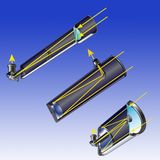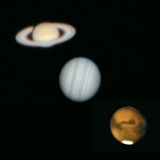
When it comes to astronomical observations, it is important to note what your sky conditions are. The reason is simple enough - sky conditions affect how you see things. You may find, like most amateur astronomers, that you'll enjoy keeping a record of your observations. Understanding how to assess and log factors such as transparency, limiting magnitude and stability are important contributions as to how, and when, you can see certain astronomical subjects. By reading the tips below, you'll be better equipped to more accurately record sky conditions in your observing journals.
Transparency or Clarity
If you have ever taken notice of a blue sky, then you know there is more than one shade of blue. One day it might be pale, the next day a break-your-heart shade that seems like it almost has purple in it. This is caused by transparency - the volume of moisture in the atmosphere - and the amount of thin cloud cover (or even pollutants) at any given time. This same transparency factor carries over into the night. While it might be dark, just how dark is it? Darkness or transparency is judged on a scale of one to ten, with one representing totally cloudy and ten representing maximum clarity. For example, a slightly hazy sky would have a transparency of around five or six. A partly cloudy sky might be considered a three. A perfectly clear night high in the mountains with no Moon, where stars seem to have a life of their own could be a nine! You can even have a moonlit night where very little light is scattered by thin clouds... a seven! The most important thing is to be consistent on the numerical value you assign to any given evening's transparency factor because it affects limiting magnitude.
Limiting Magnitude
The next factor to help you judge sky conditions is limiting magnitude , which indicates the faintest star you can see without optical aid. To assist, you will need to know the magnitude of several stars visible at the time of your observation. You can find this information on almost all star charts. For example, if you were viewing during the summer in the northern hemisphere, you might use such stars as Alpha Cygni (Deneb) with a magnitude of 1.2. Now take a look at Beta Cygni (Albireo). It has a magnitude of 3.1. Next, try 61 Cygni, which has an apparent magnitude of 5.2. If you can see this star, then the limiting magnitude of your sky is at least 5. These stars are only examples, and you can use any star for which you have a given magnitude. Take your samples from various positions around the night sky and list the faintest you can see! Always be sure to wait until you are fully dark adapted.
Stability
The next factor in judging sky conditions is stability. This is how "steady" the sky - and the image in your eyepiece - appears to be. Stability can be attributed to atmospheric conditions, or it may be nothing more than rising heat. Using your telescope, take a look at several stars in different locations in the sky. You will be judging stability, like transparency, on a scale of one to ten. Stars seen near the horizon will almost always appear to twinkle, wink in and out and move around. This is an unstable viewing condition and would rate around a two. If you are looking high above the horizon and the view looks like it is under running water, you might have great clarity, but poor stability. To help you further refine your reading, take a look at something which relies on stability to be seen, like the reasonably close double star Polaris. Does the image split into two stars easily? Do you have to focus and refocus again? If so, you might have a slightly unstable sky. However, don't make a hasty judgment. Ask yourself two very important questions: (1) Are your telescope optics at ambient temperature? And (2) Is your telescope set up in a place that might cause temperature "waves" like a concrete or blacktop surface? These two factors also play a very important role in how you see things. An unstable sky won't stop you from viewing, but never being able to come to perfect focus because of image waiver could cause you to miss small details which would otherwise be visible.
Putting It All Together
Now that you've judged your sky conditions and marked your field notes, don't stop there. While you might have great transparency, great limiting magnitude and poor stability when the evening begins, these conditions can change in a short period of time. Sometimes you'll find the most unusual combination of conditions, too. For example, a night with poor transparency might be the most stable. After you have logged sky conditions for awhile, you'll also be able to judge what types of nights work best for certain observations. For example, very stable nights are great times to shoot for tight double stars and planetary details, while nights with exceptionally good limiting magnitude could be the time to find that extremely faint galaxy you've been craving!




















